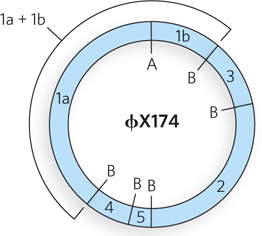DATA ANALYSIS PROBLEM
Cox, M.M., and I.R. Lehman. 1981. Directionality and polarity in RecA protein–
Question 13.15
The RecA protein promotes DNA strand exchange, as shown in Figure 13-11, with a unidirectional branch migration proceeding around the DNA circle. The direction of the branch migration was established by Cox and Lehman. A circular chromosome from bacteriophage ϕX174 can be isolated as either a single-

Question 13.16
A DNA strand exchange reaction was initiated with the RecA protein and ATP. At various times, aliquots were removed and treated with restriction enzyme B and with a nuclease that selectively digested all single-

Radioactivity is present throughout the single-
stranded DNA circle, so why is there no radioactivity in any of the restriction fragments at the beginning of the experiment? In what direction does RecA-
mediated branch migration proceed? At the end of the experiment, the amount of fragment 1b begins to decline. Suggest an explanation.